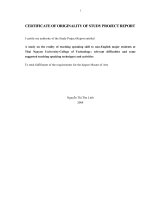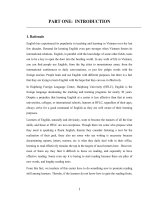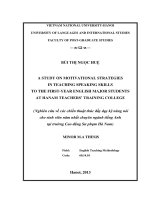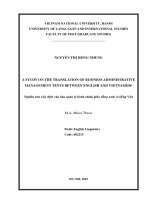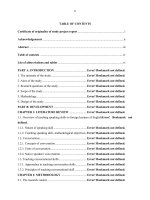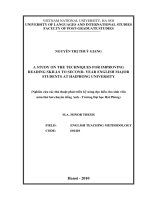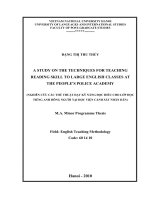(Luận văn thạc sĩ) a study on the reality of teaching conversational skills to non english major students at phuong dong unversity difficulties and some suggested teaching techniques
Bạn đang xem bản rút gọn của tài liệu. Xem và tải ngay bản đầy đủ của tài liệu tại đây (764.59 KB, 17 trang )
VIETNAM NATIONAL UNIVERSITY, HANOI
UNIVERSITY OF LANGUAGES AND INTERNATIONAL STUDIES
FACULTY OF POST- GRADUATE STUDIES
Hoàng lê hanh
A study on the reality of teaching conversational skills to nonEnglish major students at Phuong Dong University: difficulties and
some suggested teaching techniques
( Nghiên cứu thực trạng của việc dạy các kỹ năng hội thoại cho sinh viên
không chuyên tiếng anh tại tr-ờng Đại học Ph-ơng Đông: khó khăn và các kĩ thuật
giảng dạy)
M.A. Minor Programme Thesis
Field: English Teaching Methodology
Code: 60.14.10
Hanoi – 2011
VIETNAM NATIONAL UNIVERSITY, HANOI
UNIVERSITY OF LANGUAGES AND INTERNATIONAL STUDIES
FACULTY OF POST- GRADUATE STUDIES
Hoàng lê hanh
A study on the reality of teaching conversational
skills to non-English major students at Phuong Dong
University: difficulties and some suggested teaching
techniques
( Nghiên cứu thực trạng của việc dạy các kỹ năng hội thoại cho sinh viên
không chuyên tiếng anh tại tr-ờng đại học ph-ơng đông: khó khăn và các kĩ
thuật giảng dạy)
M.A. Minor Programme Thesis
Field: English Teaching Methodology
Code: 60.14.10
Supervisor: Ngun ViƯt Hïng, MA
Hanoi – 2011
iv
TABLE OF CONTENTS
Certificate of originality of study project report ............................................................... i
Acknowledgements .............................................................................................................. ii
Abstract ............................................................................................................................... iii
Table of contents ................................................................................................................ iv
List of abbreviations and tables ........................................................................................ vi
PART A: INTRODUCTION ............................................ Error! Bookmark not defined.
1. The rationale of the study ................................................ Error! Bookmark not defined.
2. Aims of the study ............................................................. Error! Bookmark not defined.
3. Research questions of the study ....................................... Error! Bookmark not defined.
4. Scope of the study ............................................................ Error! Bookmark not defined.
5. Methodology .................................................................... Error! Bookmark not defined.
6. Design of the study .......................................................... Error! Bookmark not defined.
PART B: DEVELOPMENT ............................................. Error! Bookmark not defined.
CHAPTER 1: LITERATURE REVIEW ........................ Error! Bookmark not defined.
1.1. Overview of teaching speaking skills to foreign learners of EnglishError! Bookmark not
defined.
1.1.1. Nature of speaking skill ............................................. Error! Bookmark not defined.
1.1.2. Teaching speaking skill- methodological objectives . Error! Bookmark not defined.
1.2. Conversations ................................................................ Error! Bookmark not defined.
1.2.1. Concepts of conversation ........................................... Error! Bookmark not defined.
1.2.3. Units of conversation ................................................. Error! Bookmark not defined.
1.2.4. Native speakers' conversation .................................... Error! Bookmark not defined.
1.3. Teaching conversational skills ...................................... Error! Bookmark not defined.
1.3.1. Approaches to teaching conversation skills ............... Error! Bookmark not defined.
1.3.2. Principles of teaching conversational skill ................ Error! Bookmark not defined.
CHAPTER 2: METHODOLOGY ................................... Error! Bookmark not defined.
2.1. The research context ..................................................... Error! Bookmark not defined.
v
2.1.1. Description of the English course for non-English major students and its objectives at the
faculty of foreign languages, Phuong Dong University....... Error! Bookmark not defined.
2.1.2. Description of the students at Phuong Dong UniversityError! Bookmark not defined.
2.1.3. Description of the teachers at Phuong Dong UniversityError! Bookmark not defined.
2.2. Methods of the study..................................................... Error! Bookmark not defined.
2.3. Research design ............................................................ Error! Bookmark not defined.
2.3.1. Sample and sampling ................................................. Error! Bookmark not defined.
2.3.2. Research Instruments ................................................. Error! Bookmark not defined.
2.3.3. Data collection ........................................................... Error! Bookmark not defined.
2.3.4. Data analysis .............................................................. Error! Bookmark not defined.
CHAPTER 3: FINDINGS AND DISCUSSION .............. Error! Bookmark not defined.
3.1. Teachers and students’ personal information ............... Error! Bookmark not defined.
3.2. Difficulties from teachers and students......................... Error! Bookmark not defined.
3.2.1. Students’ English proficiency and learning motivationError! Bookmark not defined.
3.2.2. Students’ attitudes toward speaking skill ................... Error! Bookmark not defined.
3.2.3. Teachers/ students’ perception of English conversationsError! Bookmark not defined.
3.2.4. Difficulties of teaching and learning conversations and conversational activities in classesError!
Bookmark not defined.
3.3. Suggested techniques and activities for teaching conversational skills to non- English major
students ................................................................................ Error! Bookmark not defined.
3.3. 1. Overview of teaching problems ................................ Error! Bookmark not defined.
3.3.2. Suggested teaching techniques to improve the effectiveness of teaching conversations to
non-English major at Phuong Dong University ................... Error! Bookmark not defined.
3.4. Activities used in conversation classes to improve students’ conversational skillsError!
Bookmark not defined.
PART C: CONCLUSION ................................................................................................. 45
1) Limitations of the study ................................................................................................... 45
2) Suggestions for further study .......................................................................................... .45
REFERENCES ................................................................... Error! Bookmark not defined.
APPENDICES .................................................................... Error! Bookmark not defined.
VIETNAM NATIONAL UNIVERSITY, HANOI
UNIVERSITY OF LANGUAGES AND INTERNATIONAL STUDIES
FACULTY OF POST- GRADUATE STUDIES
Hoàng lê hanh
A study on the reality of teaching conversational skills to nonEnglish major students at Phuong Dong University: difficulties and
some suggested teaching techniques
( Nghiên cứu thực trạng của việc dạy các kỹ năng hội thoại cho sinh viên
không chuyên tiếng anh tại tr-ờng đại học ph-ơng đông: khó khăn và các kĩ thuật
giảng dạy)
THESIS SUMMARY
Field: English Teaching Methodology
Code: 60.14.10
Supervisor: Ngun ViƯt Hïng, MA
Hanoi - 2011
PART A: INTRODUCTION
1. The rationale of the study
The actual performance of English speaking tests showed that students were more
confident in speaking individually if they had information for the teachers‟ questions. However,
when they were asked to interact with other student in conversations, they spent a lot of time
preparing for these and finally still felt worried and did an unnatural and unstructured
conversation. Some of them even failed to speak from the very beginning of the conversation.
The result of the interviews and tests suggested me a topic for my minor thesis in the Master
course in English Teaching Methodology; that is “A study on the reality
of teaching
conversational skills to non-English major students at Phuong Dong University (PDU):
difficulties and some
suggested teaching techniques.” The paper attempts to clarify the
difficulties of teaching conversational skills and suggest some activities that are practical in
teaching these skills in English speaking lessons. Some suggestions in teaching and learning
methods are also put forward, which are relevant to CLT application.
2. Aims of the study
The research investigates the reality of teaching conversational skills to non-English
major at Phuong Dong University. The main goal of the research is to identify the difficulties of
teacher and students when they deal with conversational skills to recommend techniques and
activities in classes to help teachers reduce difficulties.
3. Research questions of the study
The study aims at answering the following questions
1. What are the difficulties of teachers at Phuong Dong University conversational skills to nonEnglish major students?
2. What are the difficulties of non-English major students at Phuong Dong University when
learning conversational skills?
3. What techniques and activities are effective to teach non-English major students at Phuong
Dong University conversational skills?
4. Scope of the study
In this study, the investigator intended to focus on the difficulties of teachers and non
English major students when they teach and learn conversational skills. Because these obstacles
are the common worry among teachers and learners and from these difficulties, techniques are
selected to help teachers reduce them in teaching and help students to have more confidence in
conversing in English classes.
5. Methods of the study
To fulfill the above aims, the investigator has chosen both qualitative and quantitative
methods for the study. All the comments, remarks, suggestions and conclusions are drawn out
from factual research, observation, experience and discussion among teachers and learners. Data
for analysis are gained through the following sources:
-
Survey questionnaire: This method is used to find out the difficulties the teachers and
students at Phuong Dong University face when they interact in conversation lessons. The
questionnaires are useful for getting data of the attitudes and behaviors of the teachers and
learners when facing these difficulties. It is very convenient for the researcher to conduct the
research when she does not have much time for the research and she does not need to directly do
it.
-
Interviews and observation: The methods are significant in getting more qualitative
data by getting closer to the objects of the study. Moreover, observation done by the researcher is
leading to more objective data and open new perspective of the study.
6. Design of the study
This minor thesis consists of three parts:
Part A -INTRODUCTION: states the rationale, aims, research questions and design of
the study.
Part B – DEVELOPMENT: includes three chapters:
Chapter 1- LITERATURE REVIEW: provides theoretical background that is relevant to
the purpose of the study.
Chapter 2 - METHODOLOGY: presents the methodology of the study including the
research context, methods of the study, research design
Chapter 3- FINDINGS AND DISCUSSION: deals with the data analysis of two questionnaires
designed for teachers and on English major students to find out their difficulties in teaching and
learning conversational skills and the finding of the study and suggests some useful techniques
for teaching conversational skills to non- English major students.
Part C- CONCLUSION: summarizes some main contents of the study, points out the limitations
and suggest directions for further study.
PART B: DEVELOPMENT
CHAPTER 1: LITERATURE REVIEW
1.1. Overview of teaching speaking skills to foreign learners of English
1.1.1. Nature of speaking skill
Oral skill or speaking skill among four macro skills (including listening, speaking,
reading, and writing) is considered one of the most important in learning languages. According
to Bygate (1987), speaking help learners “carries out many of their basic transactions. It is the
skill by which they are most frequently judged, and through which they make and lose friends. It
is the par excellence of social solidarity, of social ranking, of professional advancement and of
business. It is also a medium through which much language is learnt, and for many is particularly
conductive for learning.” For some language learners, learning to speak a language is learning
the language and their improvement in the language competence is the progress in speaking
competence. That results from the fact that listening and speaking skills is used much more than
reading and writing skills in daily life. Speaking and listening skills are used in daily
communications and learning these skills is learning to communicate.
1.1.2. Teaching speaking skill-methodological objectives
The development of different approaches asserts a different perspective on the importance of
speaking and teaching speaking skill. For many years, language teaching aims at helping learners
achieve linguistic competence, which is the ability to master the sounds, words, and grammar
patterns. In the mid-1970s, the notion of linguistic competence is extended to the communicative
competence-the ability to interact with other speakers, to make meaning, as distinct from the
ability to perform on discrete- point tests of grammatical knowledge. Therefore, teachers should
study what objectives materials and methods aim at when they teach speaking skills.
1.2. Conversations
1.2.1. Concepts of conversation
There are varied definitions of conversation regarding its nature and functions. In daily
life, conversation is understood as a communicative activity in which two or more people talk
about certain topics. In classes, conversation is understood by some students as a list of continual
questions and answers. However, in some well-known books, the following authors give
different views on conversation.
First, M. Bailey (2005: 42) claims that “conversation is one of the most basic and pervasive
forms of human interaction.”
1.2.2. Functions of conversation
There are few authors stating the functions of conversation. However, the most common ideas
about that come from two authors: Brown and Yule when they assert "two different kinds of
conversational interaction can be distinguished-those in which the primary focus is on the
exchange of information (the transactional function of conversation), and those in which the
primary purpose is to establish and maintain social relations (the interactional function of
conversation)” (Brown and Yule, 1983). In transactional uses of conversation the primary focus
is on the message, whereas interactional uses of conversation focus primarily on the social needs
of the participants.
1.2.3. Units of conversation
A
Turn 1
Turn 3
Turn 5
[Solicit: call]
[Solicit: request]
[Acknowledge: thank]
„Jane‟
Could I borrow your
bike, please?
„Thanks very much‟
Turn 2
Turn 4
[Give: available]
[Give: comply]
„Yes‟
„Sure, it‟s in the
garage.‟
Exchange 1
Exchange 2
Exchange 3
1.2.4. Native speakers' conversation
To learn how to make conversations successfully in English, it is best to find out the way native
speakers form a conversation. A normal conversation could follow these rules:
o usually only one speaker speaks at a time
o the speakers change
o the length of the any contribution varies;
o there are techniques for allowing the other party or parties to speak;
o neither the content nor the amount of what we say is specified in advance
(Cited from (Nolasco and Arthur, 2000: 7)
1.3.2. Principles of teaching conversational skill
Teaching conversational skills should be teaching “how”, not teaching „what‟. That means
teachers should teach students the way to make a normal conversation and the way to overcome
obstacles in conversing. Tasks and strategies they use to teach should prepare students for the
following principles of conversation.( by Richard (1990: 79-80), cited from Brown(2001, p.277))
1.3.3. Activities used for conversation classes
Nolasco and Arthur (2000) claim the significance of using different types of conversation
activities to students of other languages as follows:
o Controlled activities: give students confidence and support
o Awareness activities: Increase sensitivity in students to what they are aiming at
o Fluency activities: Give students the practice they need to use English for
communication
o Feedback tasks: Allow students to reflect on their own performance so that they
become aware of areas in which they have to improve
CHAPTER 2: METHODOLOGY
2.1. The research context
2.1.1. Description of the English course for non-English major students and its objectives at
the faculty of foreign languages, Phuong Dong University.
The study is conducted at the faculty of foreign language, Phuong Dong University where
students learning English are divided into two groups. One group majoring in English spend four
years learning English skills such as listening, speaking, reading, writing, translating, etc.
Another group majoring in Chinese, Japanese learn English as the second foreign language. They
learn integrated skills in a 12 credit course in three semesters. Students learn some textbooks
such as Know How and New Headway.
The aim of this course for non-English major students is to develop students‟ communicative
competence in English. After the course, students are expected to communicate in English at the
intermediate level. Students normally will learn English as a second foreign language and their
need after learning this course is to communicate with foreigners in spoken form. Therefore,
communicative teaching method is used as the main way of instruction and interaction in class.
2.1.2. Description of the students at Phuong Dong University
As stated above, non-English major students at the faculty of foreign languages learn
English as second foreign languages from the third semester (at the beginning of the second
year) to the fifth semester (at the beginning of the third year). They start at different levels of
English since some of them learn Chinese and Japanese as the main foreign languages before
they enter the university. Students who have a certain competence of English forget a part of
what they learned after one year learning other languages.
2.1.3. Description of the teachers at Phuong Dong University
To ensure teaching about 800 students learning English as major and non-major subjects,
the faculty of foreign languages employs and hires about 20 teachers. Most of them graduated
from some institutions of training teachers of English such as: The College of foreign studies,
Viet Nam National University, and Ha Noi University. The qualification status of the teaching
contingent is that 10% have doctoral degree, 70% have MA degree and the rest have bachelor
degree. Most of the teachers are enthusiastic and active in teaching. The frequent meetings or
discussions on how to improve the teaching and learning quality are held to get new ideas about
changing teaching and learning methods as well as adapting materials appropriate to students.
2.2. Methods of the study
The study employs both quantitative and qualitative research methods. This is, according
to Wisker.G (2001:138) “a common approach”. Questionnaires are used as a kind of quantitative
method of study to collect information from teachers and students. The questionnaires include
both closed and open-ended questions which give teachers and students chance to express their
opinions on the difficulties of teaching and learning conversational skills as well as their
favourite techniques in teaching these skills. Besides, interviews and group observation are used
to get quantitative data for the study. Interviews get the research get closer to the participants
who are teachers and students. Their in-depth thinking noted during the interviews will help the
researcher have more insight looks into the study issue. Moreover, observations give a condition
for the researcher to check whether the teachers and students do what they say in the lessons.
2.3. Research design
2.3.1. Sample and sampling
The data of the study is collected from two main sources: survey questionnaires and interviews.
The survey questionnaire is conducted among 10 teachers who have from 3 to 10 years
experience in teaching non-English major students at Phuong Dong University. The
questionnaires for students are delivered to 100 students learning in three groups. They are
majoring in Chinese and Japanese and learning English as a second foreign language. They are
second-year students who are taking part in a second semester of their English course.
2.3.2. Research Instruments
The data for the study comes from both a quantitative method called survey questionnaires,
and two qualitative methods namely interview and group observation.
2.3.4. Data analysis
Data analysis is not only the process of reading out the data collected but the process of
interpreting the data under the viewpoint and experience of the researcher. The analysis will
bring a lot of suppositions in the research questions into light. These results will be presented in
forms of tables and charts that help to compare different viewpoints of teachers and students on
the research problems.
CHAPTER 3: FINDINGS AND DISCUSSION
-
Students’ difficulties
Question 7: What difficulties do you meet when you learn conversations?
- Teachers’ difficulties
Question 7:
What difficulties did you meet when teaching conversations to non
English major students?
-
Table 13: Teachers’ difficulties
Conversational activities in classes
-
Question 8: Which activities has your teacher used to teach conversations?
-
Table 14: Conversational activities in classes
Question 9: What is the attitude of non English major students toward your conversation
lessons?
-
3.3.
Table 15: Students’ attitude toward conversation activities
Suggested techniques and activities for teaching conversational skills to non-
English major students
-
3.3. 1. Overview of teaching problems
-
- Students‟ insufficient command of English and low motivation
-
- Students‟ passiveness and ignorance in classes Third, large and multilevel classes
-
- Large classes and students‟ use of mother tongue
-
- Students‟ lack of ideas and speaking errors
-
- Teacher‟s talking time and feedback on students‟ performance
-
3.3.2. Suggested teaching techniques to improve the effectiveness of teaching conversations
to non- English major at Phuong Dong University
a) Students‟ insufficient command of English and low motivation
b) Students‟ passiveness and ignorance in classes
c) Large classes and students‟ use of mother tongu
d) Students‟ lack of ideas and speaking errors
e) Teacher‟s talking time and feedback on students‟ performance
3.4. Activities used in conversation classes to improve students’ conversational skills
According to Nolasco and Arthur (2000), there are some basic steps in teaching conversational
skills to students ranging from controlled activities to free ones.
a. Step 1- Controlled activities
b. Step 2: Awareness activities
c. Step 3: Fluency activities
PART C: CONCLUSION
1) Limitations of the study
The study is done during a semester which last four months when the researcher is still learning
and teaching. The time limitation does not allow her to carry out a quasi experimental research in
which she can experiment the suggested techniques and activities in her real teaching. Instead of
that, survey questionnaires and interviews are use to explore the problems she searches for.
However, the number of participants can not present for all non-English major students so the
findings might not be applied for all the subjects of the study. The limitations would be avoided
if the numbers of the participants were duplicated and the findings were checked or
experimented.
2) Suggestions for further study
The study may be named “Teaching conversational skills to students at….” following the
procedure of experimental research. The students will be divided into two groups: controlled
and experimental groups and the researcher could experiment teaching conversations to students
using the suggested techniques. Yet, this suggestion would be more appropriate to a bigger
research which lasts for at least one year. That time is sufficient for preparing and doing the
research.
